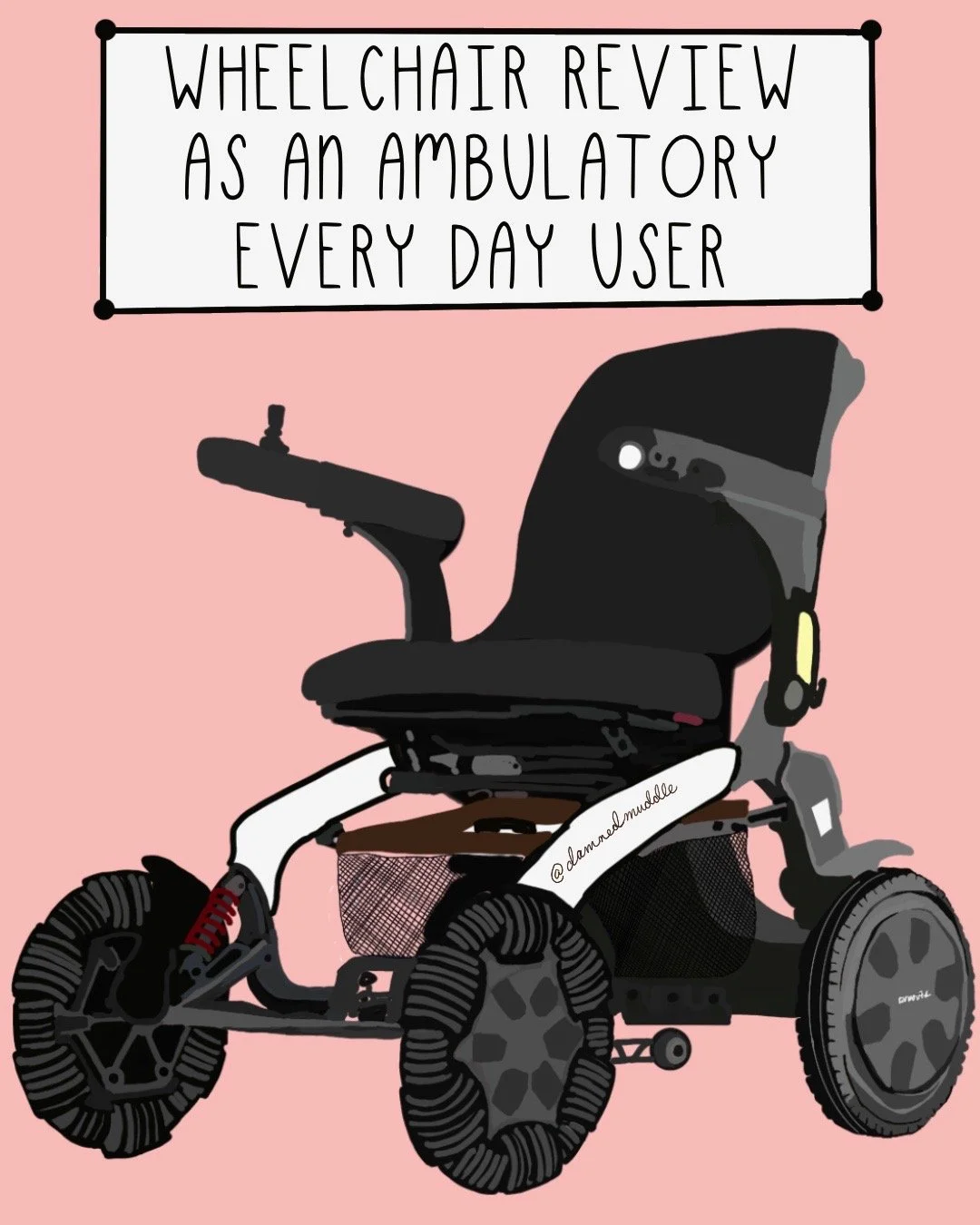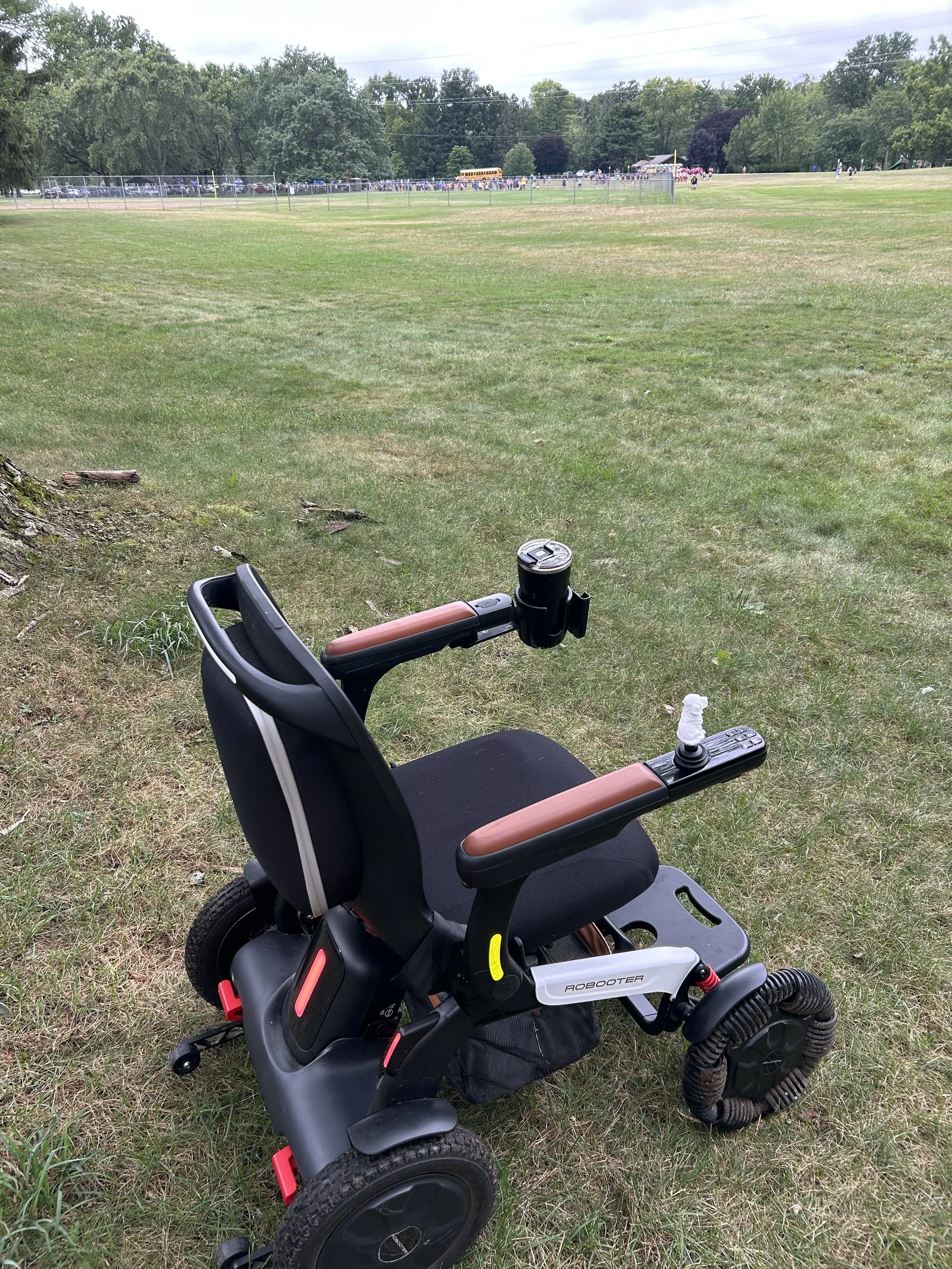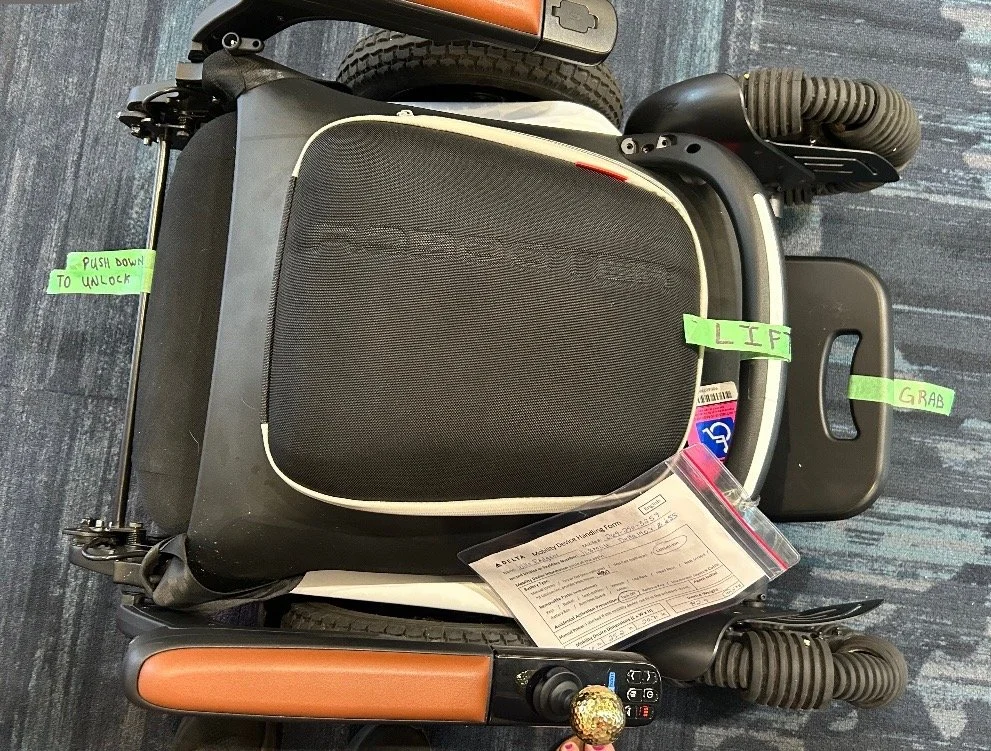Wheelchair review
Illustration of a Robooter Pro 60 electric wheelchair with handlettering that reads, "Wheelchair review as an ambulatory every day user."
If you’ve been watching my stories, you probably know I recently traveled with my wheelchair for the first time. Now that I’ve put this chair through just about everything, I am ready to share a thorough review.
I got my wheelchair about 8 months ago because my disabilities have been worsening consistently to the point where I am using a mobility aid every day. My first experience using a wheelchair was three years ago when traveling to Disney with my kids’ band trip. After trying the first two days without any aids and being unable to sleep because of the joint pain, we rented a manual which my husband pushed me in the rest of the days in the park.
The following summer we went on a cruise and while I walked throughout that trip, it was a struggle. I definitely didn’t go as many places as I had hoped because I was having trouble standing and walking for long periods of time. On the return trip I utilized the airport’s wheelchair services because my body was so worn down by that point.
That fall we traveled to Montreal and I realized just how much my inability to stand and walk long distances was affecting our experiences. After that we stopped traveling for a while because I knew we needed some time to come up with solutions that worked.
A lot of research went into the purchase of this wheelchair because it is a significant cost and because I needed very specific things from its use. I own a manual wheelchair with motorized attachment and had hoped that would work for my needs, but found it unable to handle most surfaces.
My youngest son is a senior and one thing that was very important to me was being able to see his last cross country season. Cross country courses rarely have paved paths and when they do, it means I won’t necessarily be placed where needed to see the action. I needed an all terrain chair with a very high weight limit. Many mobility devices have weight limits that end at 250lbs or lower.
The Robooter E60 Pro arrived here in January and I’ve been practicing with it ever since. At first it was rough. One of the challenges with this chair (not sure if it’s all electrical chairs) is that I need the speed set higher in order to turn well, especially on carpeting. Because it’s annoying to constantly switch between speeds, that means I almost always have my speed set at the highest (5) which works almost always but can get going a little fast at times and it was an adjustment to learn to ease into the stop.
Because of this (and my lack of spatial awareness) I broke off my first cup holder/phone attachment in just a couple days. I have gotten better in time and have made compromises. My home has a very open living room/kitchen area, but everything else is a tight squeeze. For this reason , I use the chair a lot in the main area and get up and walk down the hall because I still have that privilege/ability.
Picture of an electric wheelchair at a cross country meet
This week I got to use the chair at its first cross country meet. It was a good challenge because it rained for the first time in about a month that day. Soft grass and gravel is still a challenge even with the all terrain. The softer the turf, the harder steering becomes. But it handled the course without any trouble and allowed me to see much more of the race than I have ever been able to see walking and (almost) keep up with my husband who runs between points on the course.
The Robooter E60 Pro is built with omnidirectional front wheels which allow it to turn basically in place and handle more terrain. The downfall is that they don’t have any of their own power/traction so if one of those wheels gets in a groove or I don’t have the chair aligned correctly, controlling it and going where I want gets much more difficult.
The other challenge would come with any chair and that’s the accessibility of places. I live in a small village and am one of the only people I have seen regularly using a wheelchair. None of the businesses have automatic doors and going in and out would be near impossible without someone to help with the door.
Picture of a white and black robooter pro 60a next to a mint green suitcase at an airport
We’ve also been able to thoroughly test the folding and traveling capabilities. The nice thing about my chair is that it folds up and can be carried much like a two wheel suitcase. The challenging thing is that it weighs 83lbs. While I have managed to lift that on my own, it’s obviously a challenge so my partner does it most of the time.
My youngest son is a senior and one thing that was very important to me was being able to see his last cross country season. Cross country courses rarely have paved paths and when they do, it means I won’t necessarily be placed where needed to see the action. I needed an all terrain chair with a very high weight limit. Many mobility devices have weight limits that end at 250lbs or lower.
The Robooter E60 Pro arrived here in January and I’ve been practicing with it ever since. At first it was rough. One of the challenges with this chair (not sure if it’s all electrical chairs) is that I need the speed set higher in order to turn well, especially on carpeting. Because it’s annoying to constantly switch between speeds, that means I almost always have my speed set at the highest (5) which works almost always but can get going a little fast at times and it was an adjustment to learn to ease into the stop. was really anxious about trying air travel for the first time. There are countless horror stories about airlines breaking the chairs. I flew Delta and called ahead of time to tell them I was traveling with a wheelchair.
I was asked the following by a nice older woman named Ethel:
Wet or dry battery
How much does it weigh with and without battery
Dimensions both folded and unfolded
Whether or not I can walk without it or need transport to my seat (I can)
I was then told I just drive it up to the plane and hand it off. If I had tried to do this there probably would have been difficulties.
What we actually did was take pictures of the wheelchair from all angles before the trip, label the wheelchair with bright masking tape and a sharpie where to grip, pull, etc…, and print off a form with most of this info and talk to the gate agent each time before the flight (note: the gate agent for your flight won’t be there until about an hour before) and they attached said sheet and a disability placard to the chair and instructed me once again to pre-board and just take it up to the plane and hand it off.
Even this looked different on the two different trips to and from my destination. On the first they announced pre-boarding and the person handling my wheelchair introduced himself to us. I informed him we would collapse it for him and we had labeled all the parts, but that it was very heavy.
I also removed my joystick cover and put it in my carry on, because I thought if anything were to come off and get lost, it would be that. When we got to our destination the chair was there waiting as expected (on the later side of unloading), but to our surprise it was unfolded. So we learned to also label/explain how to collapse and unfold the chair.
On the return trip when I introduced myself to the gate agent and explained I would be traveling with the wheelchair and still had all of the paperwork attached from before (we were only at our destination a couple of days during which we didn’t use the chair a whole lot). Unlike the first trip, the gate agent told me to take out the battery (because it’s lithium ion) and take it on the plane with us. I explained to her that we hadn’t on the first trip and she said we always should and made it seem very important.
This is why I was worried when my husband forgot the battery and left it in the chair on the return flight anyway. As I freaked out about blowing up our plane, he explained that if it were that important, they would have ensured it happened. He had a point.
picture of a collapsed robooter pro 60a electric wheelchair with labels for flying on an airplane and a gold golf ball on the handle
Just like before, the wheelchair was presented unfolded at the gate without any damage. In fact, the airline did great with my wheelchair, it was me that seemed to have caused it problems in my effort to find a joystick option that works for me ergonomically. Since I want to save you from my mistakes I will tell you, don’t use a golf ball.
While golf balls are great ergonomically, I think they are too heavy and mess with the joystick mechanism enough to upset the electronics in the chair, at least I think this is what happened on my trip. Because my golf ball was a home solution and not properly done, I often had to mess with it to get it on right. By the end of the trip, all that messing had upset the electronics enough that I was often getting an error message when I attempted to turn it on. This is not what you want when trying to go through security.
After we got home I did some research I probably should have done beforehand and learned that there are creators making custom joystick covers. Not only did I get myself a lighter round one (3D printed), but I found a shop where I can order covers for different holidays and other whimsy.
picture of holiday themed joystick covers for an electric wheelchair and a dog
These aren’t cheap and therefore aren’t an option for many disabled people, despite how much they may need something more ergonomic and deserve something more fun.
Of course this is just another disability tax in a long line of things we need to pay more for to exhibit comfortably in the world. We encountered a few more on our trip too.
It was my first time using a bus or shuttle with my wheelchair. We decided to try it with me on the chair so I could have some experience with it since much of this trip was also about experimenting with travel at this level of ability.
Getting on the bus and getting properly positioned was tricky for me (as were elevators and hotel doorways), but eventually I managed. What we weren’t prepared for was the shuttle driving asking us (but seemingly no one else) for a tip as we attempted to depart. I am not opposed to tipping everyone, but my husband pointed out that this felt like a fee for being disabled. On the return trip we chose to fold the wheelchair and place it on a luggage rack.
I’d love to hear how you handle this when traveling with a wheelchair or what your take is on it as a disabled person.
Overall I am really happy with my chair choice given my lifestyle. I don’t know that I would recommend this version for someone living more independently. A more lightweight version easier for lifting and handling on your own might be the way to go if you don’t have regular assistance with that kind of thing.
I am not familiar with other chairs, but I like the way the Robooter is designed to be pretty self contained and sturdy. This isn’t to say that damage can’t be done to it (as I proved with my poor choice of joystick handle), but that I have growing confidence with travel now, especially if I can hand it off to others already collapsed.
We don’t love air travel and will probably avoid it in the future where possible in favor of road trips. While the chair can fold and fit in the trunk of a car, the space it takes up isn’t insignificant. This means we’ll be hit with more disability tax on our next vehicle as we try to find something to fit the chair, service dog kennel, and luggage.
There’s nothing affordable or easy about being disabled, but having an electric wheelchair has greatly enhanced my ability to participate in more activities, for a longer period of time, with less recovery time needed. I just wish the world were more accessible to us and everyone had access to whatever mobility aids would most enhance their life.
I would love to answer any questions if you have them. Just throw them below or shoot me an email.






